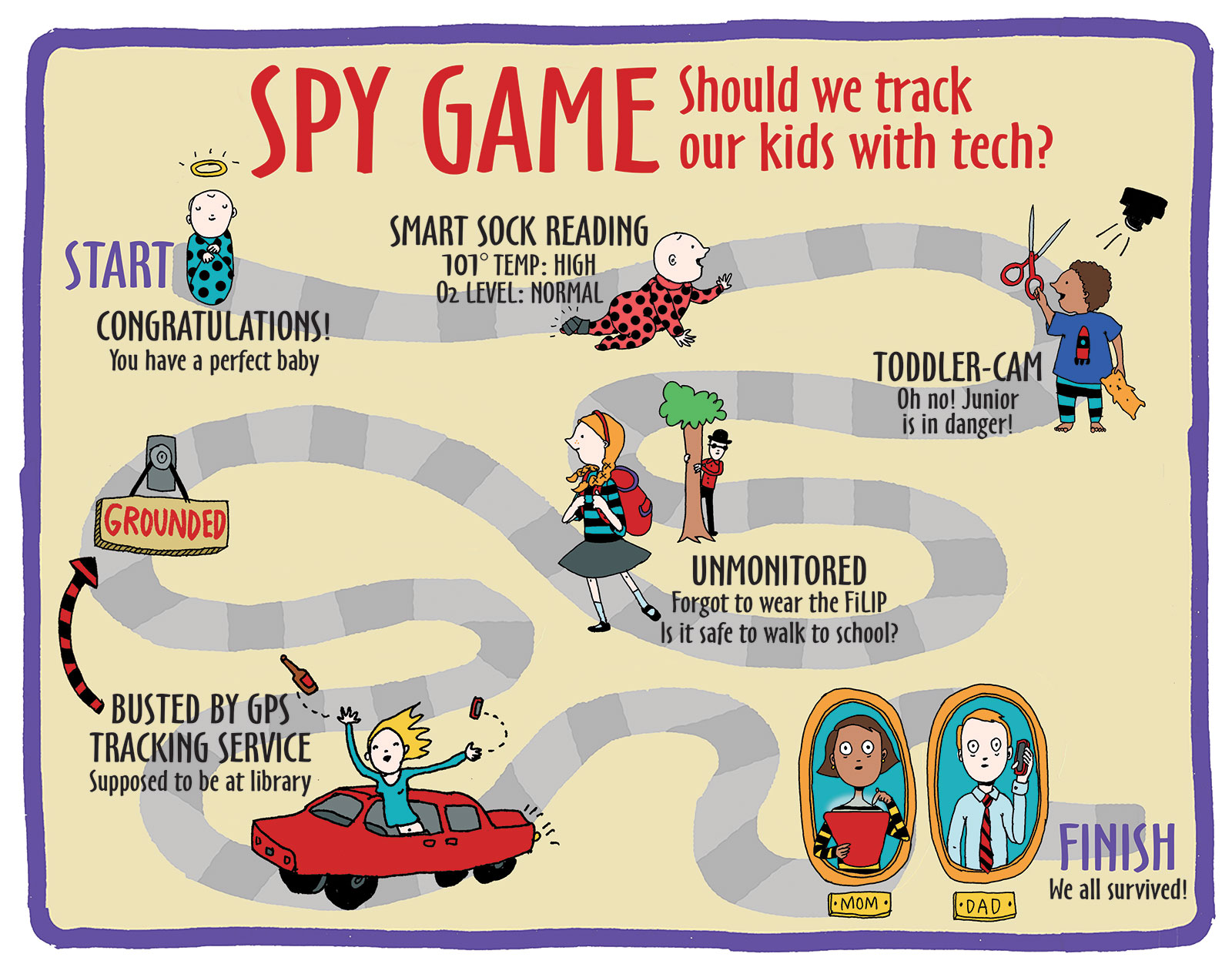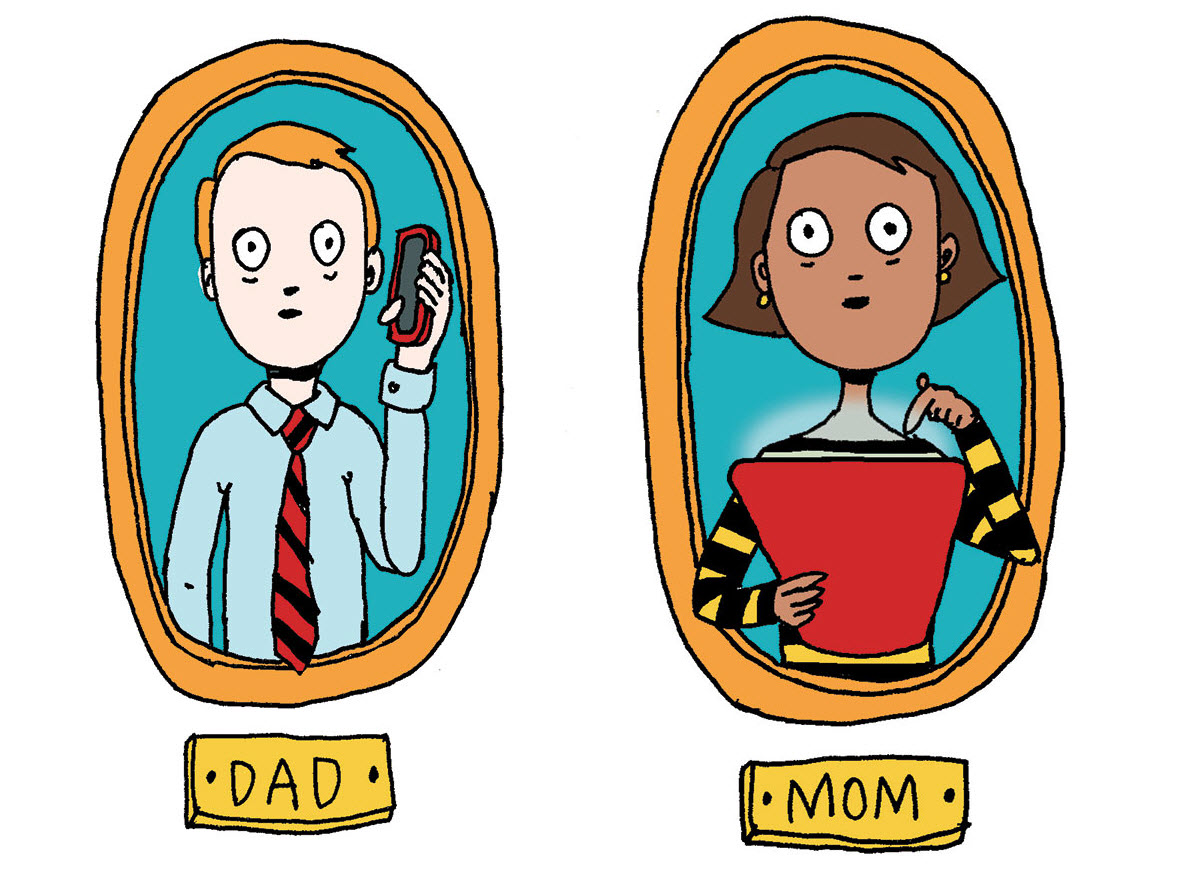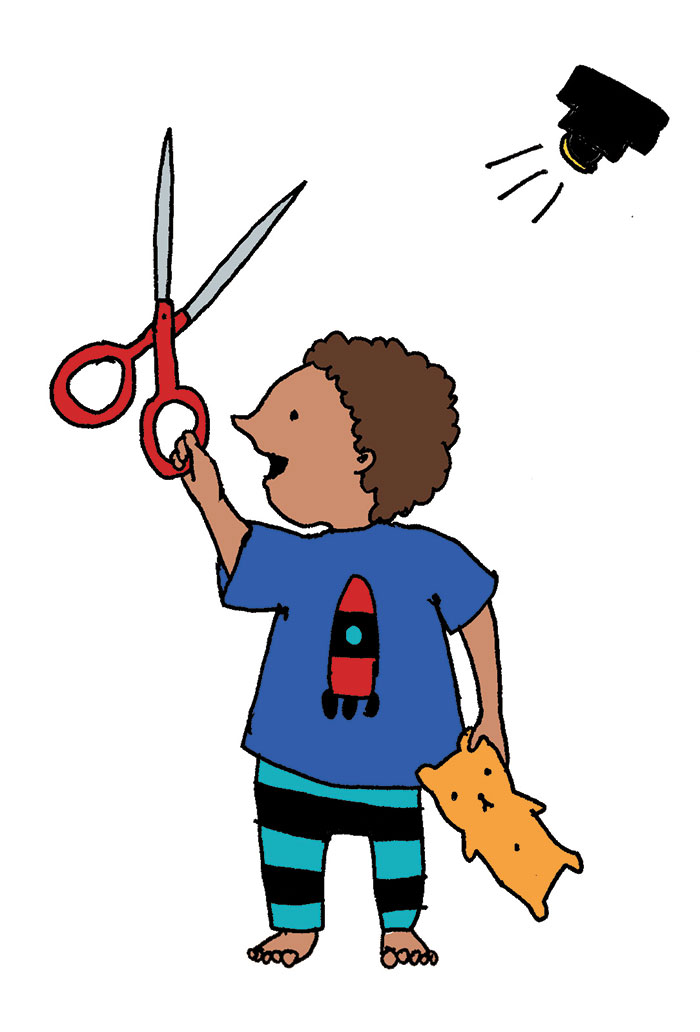As parenting moments go, there are few that are worse: You look away for a few seconds, at an incoming text message, perhaps. You look back, and your child is gone — just nowhere. You cry out his name; you rush in ever larger circles, pleading and recruiting. In the minutes that follow, you ride a tidal wave of mounting panic, full-blown anguish and frantic bargaining: Give him to me, and I will never let him out of my sight again. In that moment — as too many of us know too well — you will do anything to have your child safe again in your arms.
The luckiest among us will avoid this particular dread, but most know some form of it, at some age or stage of their child’s life. A compliant, clingy toddler who never leaves your side might morph, seemingly in the blink of an eye, into a fierce and secretive 14-year-old who’s never where she says she’ll be. You’ll do anything to find her, too.
Parenting will always be a scary business, but now at least there is some relief: A slew of new technologies are making it easier than ever to keep track of kids. The days of toddler leashes and crackling baby monitors are long gone; now you can track your tots in real time, streaming data at the touch of a button. That wayward 12-year-old who takes the long way home need no longer spike your pulse, thanks to a simple GPS device and a little geo-fencing. And no more anxious hovering over the crib, heart in your throat: Is she breathing? These days, there’s an app for that.
Newborn tech
Tracking kids with technology isn’t really new; what is new are the scope and the skew. Thanks to sensitive, sophisticated microtechnology, tracking can now begin in the crib. At this year’s huge Consumer Electronics Show (CES) in Las Vegas — where the bleeding edge of consumer technology makes its debut — one of the most talked-about gadgets was the Mimo baby monitor, a $199 wearable onesie with tiny built-in technology that monitors and transmits your baby’s respiratory, temperature and movement data to your smartphone. We might have seen this coming: The talk of last year’s CES was the Owlet Smart Sock, a baby bootie equipped with sensors that measure oxygen levels, temperature and heart rate (because, the website states, “as a parent, you’re entitled to know if your child’s heart is functioning normally”). This $250 device is now sold out; back orders are being accepted for mid-2014 delivery.
You might think that this boomlet in monitoring babelets is linked to an increasing trend in infant mortality — but you’d be wrong. Washington state’s infant mortality rate is on the decline (4.5 of every 1,000 births in 2011), and has been for years. It is, in fact, among the lowest in the country, according to the state Department of Health. But that doesn’t preclude parents from reserving the right to stack the deck with tech — especially tech-savvy parents with money to spend — and who can blame them?
The fear factor
Lenore Skenazy doesn’t blame parents — she blames the companies that create and market these devices for fanning the flames of parental fear. “Here your baby is healthy enough to leave the hospital, and you’re treating them as if they were in the NICU,” says Skenazy, the author of Free-Range Kids: How to Raise Safe, Self-Reliant Children (Without Going Nuts with Worry). “That’s a bizarre way to look at your children, and it’s the beginning of looking at your child as if they were in constant danger.”
Skenazy and other critics say the marketing of baby oxygen monitors — and most child-monitoring tech in general — crosses a line and perpetuates a heightened sense of parental fear. “Nobody would buy this type of device if someone hadn’t planted the idea in their head that somehow times are so dangerous that your child is in constant danger. It makes parents think, ‘Gee, other parents are doing this, why aren’t I?’”
 And why aren’t you? The technology, especially once the kid is clear of the crib, keeps getting cheaper, easier and — face it — more fun. Snap a colorful little GPS clip to your toddler’s Bubble Guppies tee and you can find him in a heartbeat via your smartphone. Draw a few lines on an app’s map, and you’ll get a text anytime your phone-toting tween wanders out of bounds. Heck, there’s even a whole slew of groovy bracelets that can geolocate Junior. The top dog of this tech is the FiLIP — a Jetsons-like combination of GPS, wrist phone and SOS signal all in one. A worried or lost child pushes a single button, and the FiLIP sends out an emergency beacon, begins recording ambient sound and auto-dials five people. It also comes in four colors (starfish pink! bubble blue!) and will run you $199 plus a monthly subscription fee.
And why aren’t you? The technology, especially once the kid is clear of the crib, keeps getting cheaper, easier and — face it — more fun. Snap a colorful little GPS clip to your toddler’s Bubble Guppies tee and you can find him in a heartbeat via your smartphone. Draw a few lines on an app’s map, and you’ll get a text anytime your phone-toting tween wanders out of bounds. Heck, there’s even a whole slew of groovy bracelets that can geolocate Junior. The top dog of this tech is the FiLIP — a Jetsons-like combination of GPS, wrist phone and SOS signal all in one. A worried or lost child pushes a single button, and the FiLIP sends out an emergency beacon, begins recording ambient sound and auto-dials five people. It also comes in four colors (starfish pink! bubble blue!) and will run you $199 plus a monthly subscription fee.
You can get the job done for about a tenth of the cost with one of the dozens of available kid-tracking apps — everything from simple GPS locators to more elaborate geofencing apps that allow you to set boundaries on a map and receive a text when a kid crosses out of a designated “safe zone.” Your cell service provider likely offers a range of “safe family” options — some combination of GPS, text limiters and alerts. For as little as a few dollars a month, you can keep tabs on your tots — a small investment for parental peace of mind, right?
Maybe not for some. “When you start thinking that you have to be on high alert or your child is going to die, that is not peace of mind. That is a life of constant anxiety,” says Skenazy, who also worries about the message this sends to kids. “It’s like telling them, ‘There’s no such thing as a big wide world out there for you to explore. It’s dangerous! You need your mom and dad keeping track of you at all times.’”
It’s worth noting that the risk of your child being snatched by a stranger is astronomically small. Carri Gordon, the AMBER Alert coordinator for the Washington State Patrol, cites data from the National Center for Missing and Exploited Children: There are 800,000 children reported missing nationwide each year. Of those, about 100 are true stranger abductions, i.e., perpetrated by someone other than a family member or someone known to the child. But that doesn’t stop many of us from leaping straight to that scenario the instant our own kid goes missing. For some of us, the odds will never be small enough until there are zero kidnapped kids.
Bad track records
For many parents — especially those with older tweens and teens — kid tracking isn’t about protecting their children from the badness of others, it’s about protecting kids from themselves.
 Were it not for tracking tech, a terrifying night could have been even worse for Carolyn*, a Capitol Hill mother of two teenage girls. Her then 14-year-old daughter and a friend had climbed out of the friend’s window in the middle of the night, and the daughter wasn’t returning her mother’s frantic calls and texts. Because of her daughter’s history of “dodginess,” Carolyn had previously ordered AT&T’s GPS tracking service on her daughter’s phone but had never enabled it. She did, however, have a service that allows access to her daughter’s phone records.
Were it not for tracking tech, a terrifying night could have been even worse for Carolyn*, a Capitol Hill mother of two teenage girls. Her then 14-year-old daughter and a friend had climbed out of the friend’s window in the middle of the night, and the daughter wasn’t returning her mother’s frantic calls and texts. Because of her daughter’s history of “dodginess,” Carolyn had previously ordered AT&T’s GPS tracking service on her daughter’s phone but had never enabled it. She did, however, have a service that allows access to her daughter’s phone records.
“I texted her,” says Carolyn, “and I said, ‘Look, if you don’t text me back in five minutes, I’m going to start actively calling all of the numbers that you’ve been in contact with this evening to try and figure out where you are. So if you don’t want me calling all of your friends at 3:00 in the morning, you need to get in touch with me within the next five minutes.’ And she did.” Her daughter texted her from a far-flung Puget Sound suburb, as a matter of fact — 40 miles from her Seattle home — where she was hanging out with a couple of 18-year-old boys. Carolyn enabled the GPS after that.
Here, after all, is where the statistics actually mesh with parental perceptions: It turns out unmonitored teens are in real danger in the big world. A 2010 Washington State Healthy Youth Survey found that 40 percent of high school seniors reported drinking alcohol in the past month. Motor vehicle crashes are the leading cause of death among youth ages 15–20, according to the state. Technologies for tracking teens — primarily through cell phone records and GPS, social media and safe-driving technologies — are booming. With all the freedoms (and dangers) that the teen years bring, tracking tech can be a parent’s best friend — and a kid’s, too, if they have a sketchy record.
 “Like Breathalyzers and random urinalysis, tracking systems can allow known offenders to have a social life while being monitored for potential offense,” says Laura Kastner, Ph.D., an expert on teens and the co-author (with this writer) of Wise-Minded Parenting: Seven Essentials for Raising Successful Tweens and Teens.
“Like Breathalyzers and random urinalysis, tracking systems can allow known offenders to have a social life while being monitored for potential offense,” says Laura Kastner, Ph.D., an expert on teens and the co-author (with this writer) of Wise-Minded Parenting: Seven Essentials for Raising Successful Tweens and Teens.
“The old-fashioned ways are still the best — calling other parents for ‘check-ins,’ insisting that kids pick up or call back immediately when called,” says Kastner, but if you need a little technology, try to keep it in perspective: “Parents, like kids, need to have ‘marketing literacy’ — we need to know the difference between a useful new technology and an industry that preys on our fears.”
Setting up a little tracking tech, and letting your teen know you’re doing so, can serve as a deterrent, says Kastner. “If he knows he will be tracked, it may be just what he needs to rein in his impulses.”
‘Good’ trouble
That’s just how it worked for Carolyn, who dialed up the surveillance after her daughter’s suburban adventure, but was eventually able to back off the tracking again by striking a balance between trust and threat. “I told her, ‘I’m going to take the tracking off and trust that you are where you say you are, but if we continue to have these types of situations, I’m turning it back on, and I’m going to track you all the time,’” says Carolyn.
The loosening of the reins was a big relief to both daughter and mother. “There’s a psychological thing that happens as a parent,” says Carolyn. “You get yourself into a tizzy if you feel like you have to be tracking your kid all the time, instead of trusting them to have a conversation with you and tell you what they’re doing. And there’s a certain amount of good trouble for teenagers to get into, where they feel like they’re not just constantly being monitored.”
Skenazy agrees. “All of our favorite stories from childhood involve children going off and having adventures and having to be resourceful. We would read them with joy and a little bit of envy, because we want that to be us, and then we would approximate it in our own neighborhood. Nowadays, it’s like ‘The Lion, the Witch and the Cell Phone.’ You can’t have adventures if someone is watching you all the time.”
The key, experts agree, is balance. “The thing about all of this technology is that it’s overwhelming, because it’s new and we didn’t grow up with it,” says Carolyn. “I feel like since the day my children were born, I’ve been marketed to on a fear basis. You have to just sit back as a parent and say, ‘I can make some of this stuff work for me, but some of it is just going to keep me gripped in fear, and it’s not going to serve my kid.’ It took me so long to figure that out.”
Kristen A. Russell is a Seattle journalist and the co-author, with Laura Kastner, of Wise-Minded Parenting: Seven Essentials for Raising Successful Tweens and Teens.
*Name has been changed.
Track stars: A roundup of tracking tech for every age and stage
Baby
• Mimo baby monitor — A wearable onesie that monitors and transmits your baby’s respiratory, temperature and movement data to your smartphone.
• Owlet Smart Sock — A baby bootie equipped with sensors that measure your baby’s oxygen levels, temperature and heart rate.
• Baby Monitor HD — An app and camera that allow you to watch and hear all the action in your baby’s crib.
Elementary
• The FiLIP — A brightly colored wrist-wearable emergency phone, beacon and tracking device
• Family Tracker — Install this app on the iPhone or iPad you want to track, then use a Web browser or your own iThing to locate your kids.
• Securus eZoom — A small GPS device to tuck into a backpack that sends an alert when a child crosses out of preset “safe zones.” Also monitors and reports the speed of the car in which your child is traveling.
Tween and teen
• 5Star Urgent Response — A little gadget that attaches to a key ring and allows GPS tracking — and an emergency response system. A teen in trouble can push a button and be connected to response agents who will send for help.
• SecuraFone — An app that uses a smartphone’s built-in GPS. Offers geo-fencing and sends notifications if a teen driver speeds. Free to download; monthly subscription for iPhone and Android.
• Cell phone services — Most carriers offer services that give you access to your child’s phone and text histories, locate your child using their phone’s GPS, and allow you to put limits on phone use (disabling texting after midnight, for example) for around $5–$10/month.
















